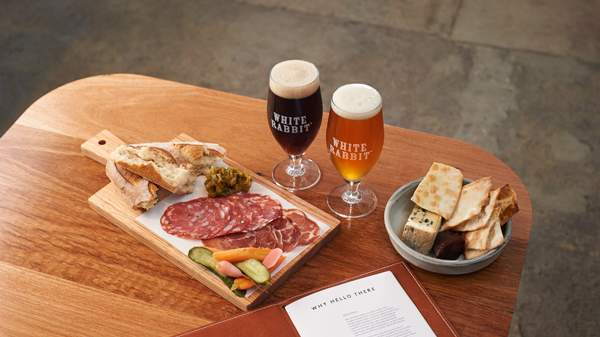In partnership with
Overview
The ploughman's lunch: it's a meal packed with old-world connotations of country living and hard labour, loved by many, even those who have never touched a plough in their lives. A standard definition is a small meal of bread, cheese and pickle, generally eaten in the middle of the day, usually served in a pub. From its time as a farmer's mainstay to the pub classic it is today, the dish has gone through many changes. When we tried the ploughman's at the White Rabbit Brewery in Geelong, we wondered, where does the dish actually come from? What is it that makes it such a legend? Here's a little bit of history, from ye olden days to the here and now.
YE OLDEN DAYS
Back in the day, the world ran almost exclusively on agriculture. Aussies were farming as early as 1788, and agriculture remains a large part of Australian trade today. This is likely why the dish remains so prominent and evokes such overwhelming cultural nostalgia – even in those who have never stepped foot on a farm.
For the farmers of old, the meal made perfect sense; clearly, the ploughmen of centuries ago didn't return home for a long lunch and siesta before finishing the day's work. Nor did they spend lunchtime hours hanging at the pub over a few pints — tough days, we know. Historians surmise that it is more likely farmers took with them some cheese, bread and pickles for luncheon, which didn't need to be refrigerated and could last out in the heat of the day. The notion of a 'pub lunch' is a much more modern and luxurious one than could have been afforded centuries ago.
FROM RAGS TO RICHES
While the meal itself was certainly a mainstay of farmers, its name, and indoctrination into society, came way, way later. The meal actually gained popularity after a nation-wide marketing push that happening between 1958 to 1977. At this time, post-war rationing was a thing of the past and businesses were not happy with the swift decline in the amount of cheese being eaten.
To whip up nostalgia for this time-honoured dish, a marketing company made a bold claim that English cheese and beer have for centuries formed a perfect combination enjoyed as the 'Ploughman's Lunch'. This is the first historical reference to the dish, which was essentially invented as a marketing ploy to sell cheese — and not just one type of cheese, but all cheeses, thus making the dish popular across all regions and allowing for the creation of endless regional versions. Of course, the combination of bread and cheese was a timeless one and an obvious accompaniment.
At that time, many rural pubs wouldn't have had a proper kitchen, so the Ploughman's Lunch was embraced as it could include simple ingredients that would be stored in the cellar and assembled easily by staff.
THESE TIMES, THEY ARE A-CHANGIN'
Once the dish was named, it was swiftly taken from the fields into the pubs. The emphasis on fresh produce, which in the past was a necessity, is a big part of why it fits so well into today's organic culture where we expect nothing less.
Since the derivation of the dish is a farce, the components of a 'traditional' ploughman's lunch are also widely open to interpretation. An entire book was written on the subject – The Definitive Ploughman's — which found that one region of England uses thirteen ingredients in their ploughman's, adding sweetcorn, olives and beetroot components to your average cheese and bread.
The variations don't stop there – Jamie Oliver's version contains spinach and fennel artisan bread and a scotch egg, while Barfoot Contessa's Ina Garten prefers an English-American fusion of thickly sliced Virginia ham and English cheddar. The restaurant within Geelong's White Rabbit Brewery allows patrons to pair any number of craft cheeses and meats, like wagyu bresaola paired with a Barossa triple cream. Each platter is served with a baguette from local bread makers Born & Bread and Yarra Valley's Cunliffe & Waters chutneys and spreads, along with pickled veg galore. This is truly the crème de la crème of ploughman's.
Also agreed upon is that a good ploughman's lunch is a true testament to the overall quality of a pub. The dish continues to take many forms, and at its fanciest, better resembles a charcuterie. But even in its simplest form, there really is nothing better than a plate of crusty bread, homemade chutney, pickled vegetables and of course, a wedge of artisan cheese. Don't forget to wash it all down with a nice cold pint — it makes the dish taste just right.
Find White Rabbit Brewery at 221 Swanston Street, South Geelong. Open Sunday to Thursday 11am – 5pm, Friday to Saturday 11am – 9pm.
